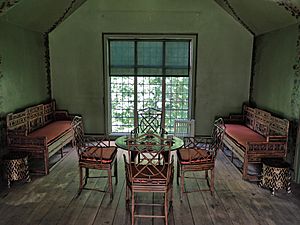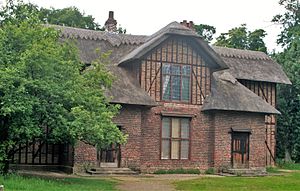Queen Charlotte's Cottage facts for kids
Queen Charlotte's Cottage is a special house from the 1700s. It's located inside the beautiful Kew Gardens in London, right by the River Thames. This charming cottage is named after Queen Charlotte, who had it built. It was finished in 1772 and is considered a very important historical building. Today, Historic Royal Palaces looks after it, and you can visit it!
Contents
Queen Charlotte's Connection to Kew
George III's mother, Princess Augusta, spent a lot of time at Kew. King George III, just like his father Prince Frederick, loved farming and gardening. Because of this, King George III and Queen Charlotte often spent their summers at Kew. They stayed in places like Richmond Lodge and what is now known as Kew Palace. It was during these visits that Queen Charlotte decided to build the cottage that now carries her name.
Cottage Design and Style
Queen Charlotte's Cottage is an example of a "cottage orné." This was a popular style for rustic-looking cottages in the late 1700s and early 1800s. These cottages were designed to look simple and natural, often with a nicely shaped thatched roof and decorative wooden details. They usually had one floor, though some had two.

Queen Charlotte's Cottage, built in 1772, is one of the very first examples of this style. It has a wooden frame with bricks filling the spaces. Some people think this design reminds Queen Charlotte of the buildings from her childhood in North Germany. The roof is made of thatch, and the simple doors are rough wooden planks with old-fashioned latches. The windows are quite large for a cottage and use recycled frames from the 1600s with small glass panes held by lead.
Inside, the cottage is more fancy than most cottages of its kind. It has two main rooms: the Print Room downstairs and the Picnic Room upstairs. A special staircase connects them. In the early 1800s, Princess Elizabeth (who learned to draw plants from Franz Bauer) painted the Picnic Room. She made it look like the inside of a bower, which is a special nest built by certain birds.
The earliest description of the cottage, from 1774, says that Queen Charlotte herself designed it. She paid for the work, but the records of her payments have been lost. There is some evidence that Sir William Chambers, a famous architect who designed the nearby Great Pagoda in 1762, helped turn the Queen's ideas into building plans. In 1805, Queen Charlotte's Cottage was made bigger with a second floor that also had a thatched roof.
The roof is made from Norfolk reed, which was the original material, and has a patterned ridge made of sedge. The cottage even has a sprinkler system for safety, and you can see some of the sprinklers poking through the thatch. The most recent re-thatching was done by Bardsley & Brown Ltd.
The Cottage Grounds
From 1792, Queen Charlotte kept kangaroos in the field behind the cottage! However, in 1806, W. T. Aiton changed this area into a beautiful flower garden.
Opening to the Public
Queen Victoria didn't visit the cottage very often, but a housekeeper always looked after it during her reign. A writer named Sir Arthur Helps lived in the cottage from 1867 until he passed away in 1875. In 1898, Queen Victoria gave both the cottage and Kew Palace to the public. This was to celebrate her diamond jubilee (60 years as queen) the year before. She asked that the grounds around the cottage be left in a natural, wild state.
Today, both Queen Charlotte's Cottage and Kew Palace, along with the Pagoda, are cared for by Historic Royal Palaces. They are all open for visitors to enjoy. In October 2021, the cottage received money from the government's Culture Recovery Fund to help with its upkeep.


